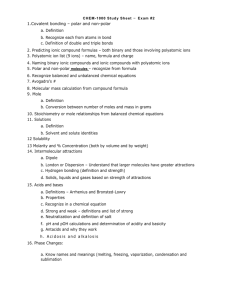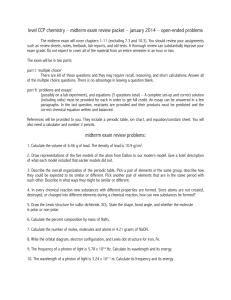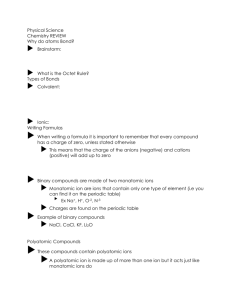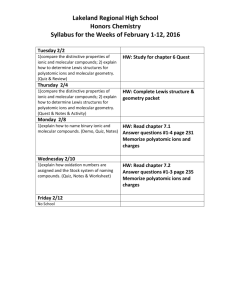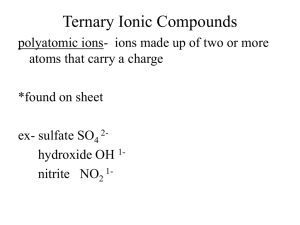Grade 9 Chemistry Unit Test Revision: Building Blocks
advertisement
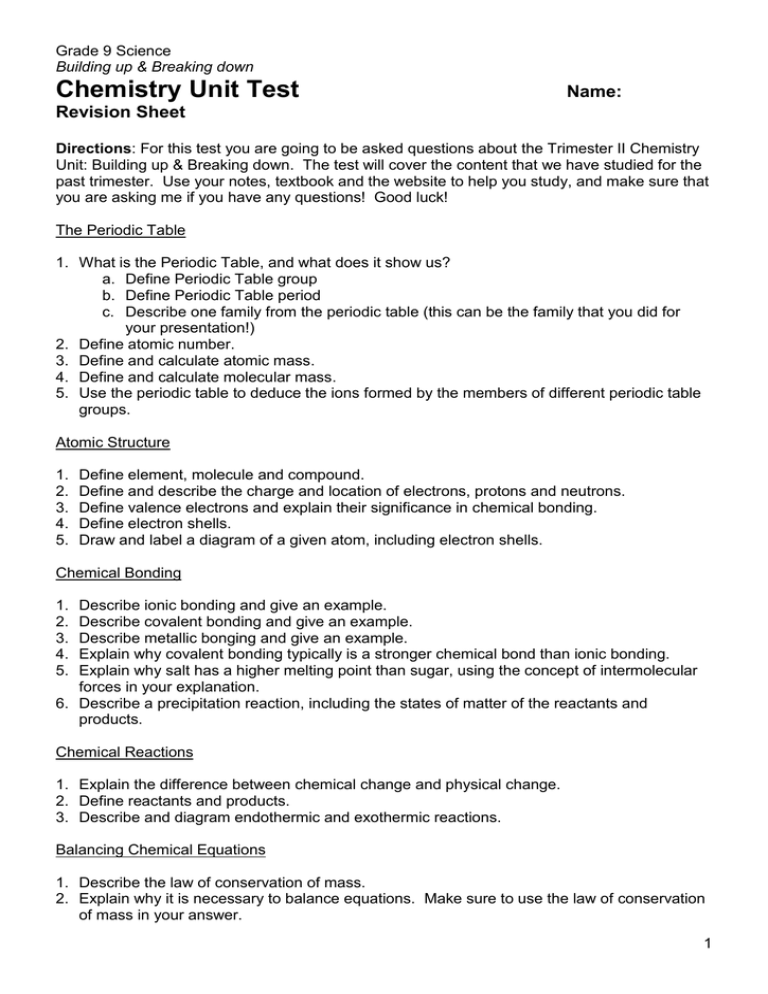
Grade 9 Science Building up & Breaking down Chemistry Unit Test Name: Revision Sheet Directions: For this test you are going to be asked questions about the Trimester II Chemistry Unit: Building up & Breaking down. The test will cover the content that we have studied for the past trimester. Use your notes, textbook and the website to help you study, and make sure that you are asking me if you have any questions! Good luck! The Periodic Table 1. What is the Periodic Table, and what does it show us? a. Define Periodic Table group b. Define Periodic Table period c. Describe one family from the periodic table (this can be the family that you did for your presentation!) 2. Define atomic number. 3. Define and calculate atomic mass. 4. Define and calculate molecular mass. 5. Use the periodic table to deduce the ions formed by the members of different periodic table groups. Atomic Structure 1. 2. 3. 4. 5. Define element, molecule and compound. Define and describe the charge and location of electrons, protons and neutrons. Define valence electrons and explain their significance in chemical bonding. Define electron shells. Draw and label a diagram of a given atom, including electron shells. Chemical Bonding 1. 2. 3. 4. 5. Describe ionic bonding and give an example. Describe covalent bonding and give an example. Describe metallic bonging and give an example. Explain why covalent bonding typically is a stronger chemical bond than ionic bonding. Explain why salt has a higher melting point than sugar, using the concept of intermolecular forces in your explanation. 6. Describe a precipitation reaction, including the states of matter of the reactants and products. Chemical Reactions 1. Explain the difference between chemical change and physical change. 2. Define reactants and products. 3. Describe and diagram endothermic and exothermic reactions. Balancing Chemical Equations 1. Describe the law of conservation of mass. 2. Explain why it is necessary to balance equations. Make sure to use the law of conservation of mass in your answer. 1 Grade 9 Science Building up & Breaking down 3. Explain the significance of coefficients, subscript numbers and state symbols (s, l, g, aq) in chemical equations. 4. Calculate the number of atoms on either side of a chemical equation. 5. Balance the numbers of atoms in chemical equations. 6. Balance the charges in chemical equations showing ionic compounds. Naming Compounds 1. State the name of compounds where a metal and a non-metal combine. 2. State the name of compounds formed by different cations of a transition metal. (EX: Fe 2+ and Fe3+) 3. State the name of compounds formed by polyatomic ions. 4. State the names of different versions of polyatomic ions. 5. Explain why a polyatomic ion stays together during chemical reactions even as it forms a new substance. Ions and Isotopes 1. Define isotope and explain the difference between two given isotopes. 2. Explain the difference between carbon-12, carbon-13 and carbon-14, including a discussion of atomic structure. 3. Define ion, cation, anion and polyatomic ion. 4. Explain the role of cations, anions and polyatomic ions in ionic bonding. 5. Explain the structure of a polyatomic ion. 6. State the charges and bonding patterns of the following ions and polyatomic ions: a. b. c. d. Cl1Na1+ OH1Fe2+ e. f. g. h. Fe3+ SO42Cu2+ NO31- Data Analysis 1. You will be given data about various compounds and will need to be able to graph that data and interpret the results. 2
